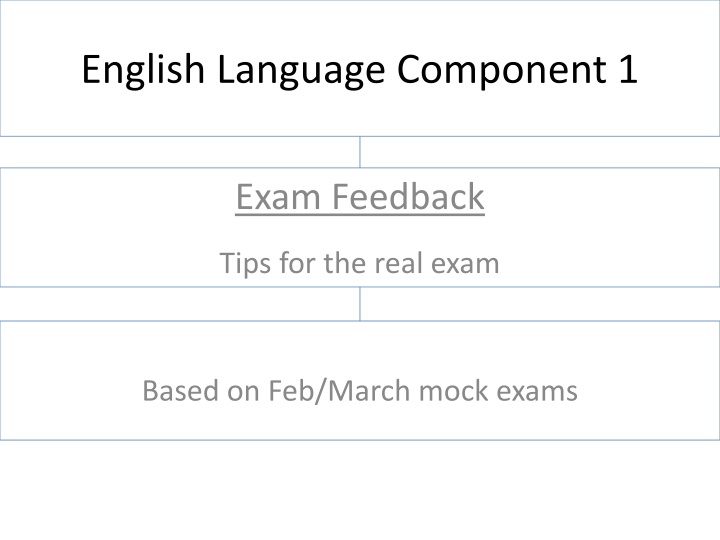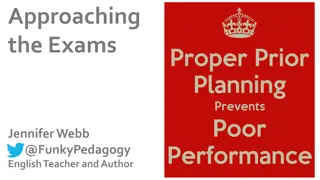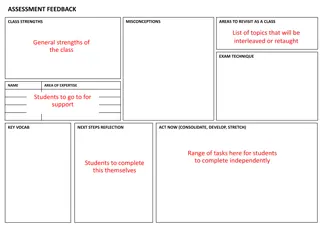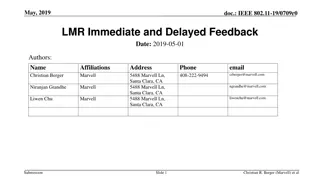Exam Feedback Tips for Real Exam Based on Feb/March Mock Exams
Reading exam tips for English Language Component 1 based on mock exams; ensure accurate quoting, explain thoughts/feelings, identify literary techniques, and effectively evaluate responses.
Download Presentation

Please find below an Image/Link to download the presentation.
The content on the website is provided AS IS for your information and personal use only. It may not be sold, licensed, or shared on other websites without obtaining consent from the author.If you encounter any issues during the download, it is possible that the publisher has removed the file from their server.
You are allowed to download the files provided on this website for personal or commercial use, subject to the condition that they are used lawfully. All files are the property of their respective owners.
The content on the website is provided AS IS for your information and personal use only. It may not be sold, licensed, or shared on other websites without obtaining consent from the author.
E N D
Presentation Transcript
English Language Component 1 Exam Feedback Tips for the real exam Based on Feb/March mock exams
English Language Component 1 Section A: Reading Exam Tip 1 Tip 1 Be CERTAIN to quote from the right lines (i.e. each question has specific line numbers) More info on Tip 1 Tip 1 For each question, you are told to read a certain number of lines (e.g. Read lines 1-11). You must only quote from lines given to get marks. You will get 0 marks if you quote from the wrong lines.
English Language Component 1 Section A: Reading Exam Tip 2 Tip 2 For the thoughts and feelings question, explain the reason for the thought/feeling How to explainthe reason for the thought/feeling The writer shows that Megan does not enjoy the train journey through references to negative descriptions of the external view of the train and Megan s experience within the train. The writer highlights Megan s discomfort because of the sense of her personal space being invaded, and her disappointment with the ugly landscape which contrasted with her expectations of England. Tip 2 You explain the thought/feeling by using a bridging words because/which/as after the thought/feeling word (e.g. Megan s discomfort because of the sense of her personal space being invaded. Using a bridging word after the thought/feeling word makes sure you explain the thought/feeling. = reason for thought/feeling = thought/feeling
English Language Component 1 Section A: Reading Exam Tip 3 Tip 3 For the How question, if in doubt use word or phrase : don t guess techniques! Look for these techniquesin the How question Adjectives (descriptive words) Adverbs (-ly words) Verbs (actions) Simile (comparisons) Personification (giving objects human qualities) Tip 3 scared happy excited grimy dark quietly quickly ferociously elegantly carefully ran shouted cried looked thought He exploded like a volcano The pale, sickly yellow lights He tip-toed silently, as if on a tightrope The house sat on the corner, observing
English Language Component 1 Section A: Reading Exam Tip 4 Tip 4 Make sure you agree and disagree in the Evaluation question How to agree anddisagree in the Evaluation question In the last section of the passage the reader feels only sympathy for Megan. How far do you agree with this view? The last section of the passage begins with a clear sense of sympathy for Megan evident in the lines Megan dragged her suitcase up the steps , the verb dragged reinforcing her lack of support and company on the trip. The reader feels further sympathy through the contrast between Megan smiling in anticipation of seeing her friend Cora and there was no reply from the top bell , creating as sense of pity for Megan. However, line 70 reduces the level of sympathy the reader feels by referring to Megan realising she d made a very foolish mistake in not waiting to hear from Cora before she travelled to England. This quotation shows that Megan is impulsive and quite immature and, in some ways, has brought the situation upon herself, therefore reducing the sympathy I feel. Tip 4 = disagree = reasons why you disagree = agree
English Language Component 1 Section B: Prose Writing Exam Tip 5 Tip 5 The Writing 5 are the five things you need to do in your story to be successful. The Writing 5: key ingredients for success The Setting (The 5 senses) Adjectives (descriptive words) synonyms (alternative words) 5 Sentences (varies pace) Punctuation ( : - ! ? ) Tip 5 Use The 5 Senses to create a vivid (detailed) setting. This gives your story atmosphere. Use adjectives to add detail to your descriptions of characters. Use synonyms (alternative words) to be more precise in your descriptions. Use The 5 Sentences to vary the pace in your story. Include Punctuation 5 to add mystery, suspense and tension to your story. suspense - suspense : tension ? mystery ! intense emotion Simple = 1 Compound = 2 Complex = 1.5 Minor = 0.5 Multi-Clausal = 3 The slender, ruby- red necklace glistened in the light The boyheaved his bike up and glared at his friend























